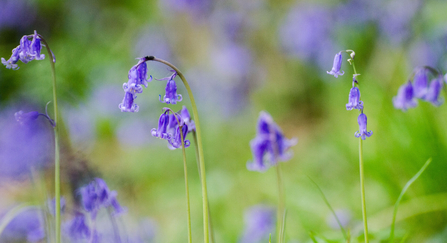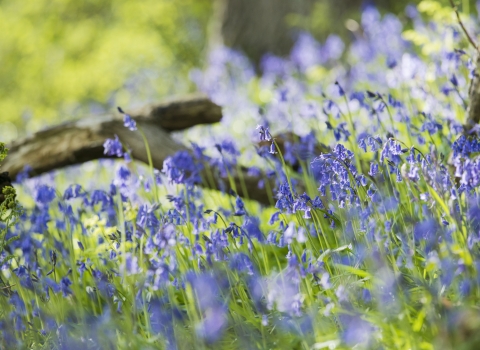There’s something magical about seeing bluebells carpeting the woodland floor. A spectacular display of blue and purple hues and a sure sign that spring is here! Did you know, however, that not all the bluebells you see are native? While they feel like an iconic British wildflower species, there’s actually a big pretender in their midst.
How to help our native bluebells this spring
How to identify a native bluebell

Josh Raper -bluebells - Josh Raper / Conservation Media
Our native bluebell is an early flowering plant that naturally occurs in the UK, seen in ancient woodlands and along woodland edges throughout April and May. You can identify them by these distinct traits:
- They have narrow leaves, around 1 – 1.5cm wide
- They have violet-blue (or sometimes white), narrow, tubular-bell flowers with tips that curl back
- Their flowers are only on one side of the stem
- Their stems have a distinctive droop to one side
- They have a sweet scent with cream-coloured pollen inside
There are bluebells on my street but their stems are straight, what are they?

WildNet - Richard Burkmar
The Spanish bluebell was introduced to the UK by the Victorians as a garden plant, but it quickly escaped into the wild! Today, they can be found alongside our native bluebells in the woods, but also along roadsides and in gardens. This is how you can identify a Spanish bluebell:
- They have broad leaves, about 3cm wide
- They have pale blue (often white or pink), conical-bell flowers, with spreading and open tips
- Their flowers are all around the stem
- They have upright stems
- They have no scent and blue- or pale green-coloured pollen inside
Can native and Spanish bluebells live happily side-by-side?

WildNet - Philip Precey
Unfortunately, Spanish bluebells can pose a threat to our native species.
The Spanish bluebell is more vigorous than our native bluebell, so can outcompete it for resources like light and space. It can hybridise with our natives, too, producing plants which show a whole range of mixed features from both species.
Over time, this hybridisation changes the genetic makeup of our native species, diluting its characteristics, weakening it and potentially evolving it into something else.
What can I do to help our native bluebells?
Wild Isles: The bluebells of Prior's Woods (https://youtu.be/8YNX6-ZvHDs)
(C) Tom Beldam/Silverback Films/BBC
Bluebells are a delicate plant, with those iconic violet-blue carpets taking years to establish in ancient woodlands. It can also take them years to recover from the damage caused by being trampled. Even if only their leaves are crushed, this can weaken them as it stops them from being able to photosynthesise.
Therefore we’d ask anyone visiting a bluebell wood, such as our own Prior’s Wood nature reserve, to be mindful of where you step. Please stick to the footpath, ensuring your dog is kept on a lead, and refrain from picking the flowers – you can remember the experience by taking blue-tiful photos instead!
The bluebell is also protected under the Wildlife and Countryside Act (1981), which means digging up the plant or bulb in the countryside is prohibited, and landowners are prohibited from removing bluebells from their land to sell. The species was also listed on Schedule 8 of the Act in 1998, which makes trading in wild bluebell bulbs and seeds an offence. This legislation was designed to protect bluebells from unscrupulous bulb collectors who supply garden centres.
If you’d like to boost the native population and plant them in your own garden, the BBC Gardener’s World website has advice and instructions for people with the right kind of green space where bluebells can thrive.


